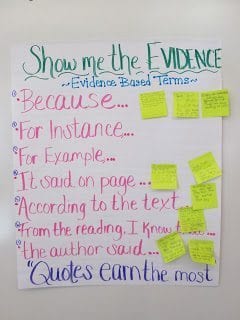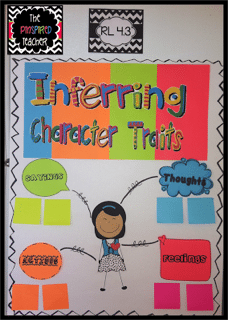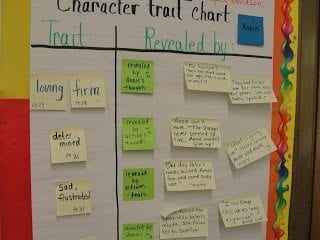Leo Tolstoy’s The Two Brothers tells the story of two brothers who are offered the opportunity to find happiness. One chooses to go on a journey and finds happiness—as well as difficulties—along the way, while the other stays at home and leads a happy but uneventful life. When Jasmine Williams’ fifth-grade students at Carter School of Excellence in Chicago read The Two Brothers, they held classroom discussions around this question: Which brother made the better choice?
Williams’ students sat in a circle, holding their books and graphic organizers filled with notes. “I believe the older brother made the best decision,” said one student, “because in the text, the author said that he weighed all the negative possibilities and risks first.” And with that first interpretation they’re off and running.
Citing textual evidence is about more than rattling off quotes from the story. It involves selecting and interpreting just the right evidence, says John Riley, the Great Books Foundation’s director of professional learning. “Ultimately, textual evidence is what makes students’ answers credible.”
Classroom discussions are a perfect place to develop students’ ability to use textual evidence. In classroom discussions, students work with multiple ideas and have to balance new ideas with their original conclusions. It’s a challenging task. Using evidence in discussion strengthens students’ comprehension and confidence. “It’s really, really good for kids,” says Jenny Knol, ESL teacher with Sumner County Schools in Gallatin, Tennessee. “I think they’re empowered by it. They feel better about themselves when they can prove something.”
As teachers know well, finding and using textual evidence is challenging for students—choosing a solid piece of evidence or creating a clear interpretation can be overwhelming. These 13-teacher and expert-tested strategies will strengthen your students’ ability to find and use evidence from any text.
1. Choose texts that inspire debate.
Stories that are driven by character actions and motivation are the ones that inspire discussion. Texts that inspire questions encourage students to return to the text and find support for their answers. Look for stories that naturally raise questions about why characters do what they do.
2. Use your greatest tool: good questions!
Questions are the greatest tool you have to prompt and encourage student thinking. By starting with one overarching focus question like “Which brother made the better choice?” you can create sequences of smaller questions that prompt students to return to the text during discussion. Some ideas: What does the character say? Why did you choose that evidence? How does the evidence support your position?
3. Get evidence from the get-go.
Require students to have evidence ready at the start of the discussion. Knol sets the expectation that her students will use textual evidence, and she tells students to “prove it” so often that they anticipate her request, have their texts open, and often return to the text before she prompts them. Requiring evidence early in the discussion sets an expectation. Reinforcing that expectation turns using textual evidence into a habit.
4. Invite multiple perspectives.
Students may think that finding evidence is proof that there’s one right answer. But in discussion, says Riley, evidence will actually open up a text to different interpretations. Citing evidence promotes the development of different ideas when students read two statements in two different ways. “Part of the Shared Inquiry™ method of learning is knowing that there are other people who will take that evidence and come up with another argument,” says Knol. And that is fine. Establish the expectation that answers can and will diverge. “The more your classroom has an inquiry focus, the more students will be able to see other perspectives.”
5. Add interpretation.
Heidi Morgan, fifth- and sixth-grade language arts teacher in New Lenox, Illinois, finds that students often want to find a quote and declare themselves done. The challenge is getting students to expand and explain. To get students to explain why they choose a piece of evidence, provide them with a structure that moves from evidence to interpretation. Williams’ students use a graphic organizer with three columns: They write their answer in the first column, note textual evidence in the second, and explain their evidence in the third.
6. Use sentence starters strategically.
Williams gives her students sentence starters to identify their evidence (e.g., “In the text … the author mentions …”). Then, she helps them make the bridge from evidence to interpretation with additional sentence starters (“the author uses this evidence to … this lets us know that …”). “The sentence starters help,” she says, “because students know the direction in which they’re supposed to go.”
7. Develop and deepen arguments.
During discussion, send students back to the text for more evidence by prompting them to expand on a classmate’s idea or deepen the discussion. Prompt students by saying, “I heard this person say something that contradicts …” or “These students all said something similar … does anyone have a different idea?” You want students to consider implications and bulk up their answers by developing their arguments, says Williams.
8. Slow down classroom discussions.
Stopping to get evidence slows the speed of discussion, and that’s a good thing. “Most discussions move too quickly,” says Riley, “and great ideas get totally lost.” Give students enough time to flip through and find just the right piece of evidence. If other students are getting antsy, choose one of your always-ready students to share, then loop back to the student who needed time with the text.
9. Practice in a pattern.
To avoid a pileup of one idea, establish a discussion structure that requires debate. Every student in Williams’ class must respond by addressing the claims of the people before them and then provide their counterclaims. “The easy part is making the claim,” says Williams. “They become masters when they are able to use evidence to knock out someone else’s claim.”
10. Go for the nitty-gritty.
Once students have answered the focus question, encourage them to get into the details. Exploring specific sentences and words can engage students with additional aspects of the text and spin off into an analysis of the author’s craft.
11. Anticipate and correct misunderstandings.
“Just because there’s more than one right answer,” says Riley, “doesn’t mean there’s no wrong answer.” If a student offers up a misunderstanding or misinterpretation, prompt him or her to go back to the text, or offer it up to the group. Either way, make sure students leave with a clear understanding of what the text said and how.
12. Encourage ownership.
Knol knows her students are making progress when she sees them move from using the prescribed list of sentence starters (“According to page …”) to putting their textual evidence in their own words. “At the beginning of the year,” she says, “they’re dependent on [the sentence starters], and by the end of the year, they use those naturally.” Listen for how students personalize the discussion, and encourage them to develop their own voice. Once students have built a repertoire of authentic starters and prompts, create an anchor chart that makes their language a part of your class.
13. Reflect.
After their Shared Inquiry™ discussions, each student writes a reflection. They answer the focus question a second time, explain whether or not they changed their answers, and reflect on how the evidence brought up during discussion impacted their thinking. Taking time to reflect solidifies the importance of textual evidence and helps students incorporate the lessons learned.
10 Textual Evidence Anchor Charts
Well-placed anchor charts are a reference for students and a tool that promotes great discussions. These 10 anchor charts will reinforce your students’ skills when it comes to finding and using textual evidence.
1. Prove It
This anchor chart merges sentence starters with examples that help students see how to present their evidence in full sentences.
2. Show Me the Evidence
Sticky notes added to this anchor chart allow you to keep it up-to-date with the best ways each sentence starter was used.
3. Infer It
For discussions that center on character decisions, this bright, bold anchor chart encourages students to use textual evidence to support their character analysis.
4. Look to the Text
Use any text to create this anchor chart that prompts students to go back to the text. This chart also reinforces paraphrasing and reminds students to put ideas from the text into their own words.
5. From the Author’s Point of View
Quotes and ideas from the text (in blue) and the ideas that come from them (in orange) reinforce the idea that you have to find evidence and use it to make a claim.
SOURCE: Around the Kampfire
6. Character Traits Revealed
This anchor chart can be used over and over as students use sticky notes to respond to different stories.
7. Tracking Text
Encourage students to get, use and think about evidence with this anchor chart. The levels and images (inner tube, snorkel and gold treasure) could also be used to give students feedback on how they’re using textual evidence.
8. Reader Response
Use this chart to track which students are proposing textual evidence (with a box for each student) or keep track of textual evidence that students find each day (with a box for each day of discussion).
9. Character Discussion
When you’re reading multiple texts about a subject, record textual evidence with different colors for each type of text (fiction and informational text, primary and secondary sources, etc.).
10. Conversation Reminders
This anchor chart keeps students grounded in the elements of a quality discussion.
By Samantha Cleaver




